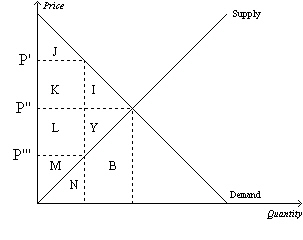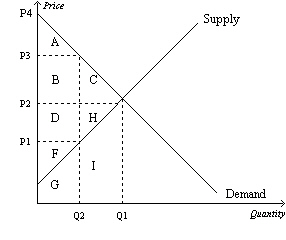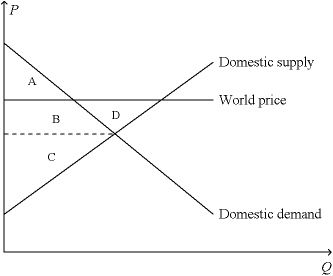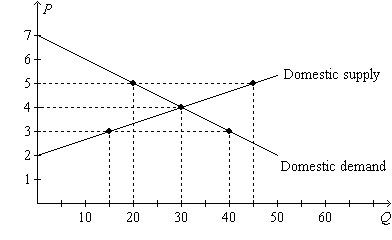Multiple Choice
Identify the
choice that best completes the statement or answers the question.
|
|
|
1.
|
To fully understand how taxes affect economic well-being, we must compare the
a. | benefit to buyers with the loss to sellers. | b. | price paid by buyers
to the price received by sellers. | c. | profits earned by firms to the losses incurred
by consumers. | d. | decrease in total surplus to the increase in revenue raised by the
government. |
|
|
|
2.
|
The benefit that government receives from a tax is measured by
a. | the change in the equilibrium quantity of the good. | b. | the change in the
equilibrium price of the good. | c. | tax revenue. | d. | total
surplus. |
|
|
|
3.
|
Taxes cause deadweight losses because they
a. | lead to losses in surplus for consumers and for producers that, when taken together,
exceed tax revenue collected by the government. | b. | distort incentives to both buyers and
sellers. | c. | prevent buyers and sellers from realizing some of the gains from
trade. | d. | All of the above are correct. |
|
|
|
Figure 1
|
|
|
4.
|
Refer to Figure 1. Suppose the government imposes a tax of P’
- P’’’. The producer surplus after the tax is measured by the area
a. | M. | b. | L+M+N+Y+B. | c. | L+M+Y. | d. | J. |
|
|
|
Figure 2
Suppose that the government imposes a tax of P3 -
P1. 
|
|
|
5.
|
Refer to Figure 2. The benefit to the government is measured by
a. | tax revenue and is represented by area A+B. | b. | tax revenue and is
represented by area B+D. | c. | the net gain in total surplus and is
represented by area B+D. | d. | the net gain in total surplus and is
represented by area C+H. |
|
|
|
6.
|
Refer to Figure 2. The loss in total welfare that results from the tax is
represented by area
a. | A+B+D+F. | b. | A+B+C. | c. | D+H+F. | d. | C+H. |
|
|
|
7.
|
With which of the Ten Principles of Economics is the study of
international trade most closely connected?
a. | People face tradeoffs. | b. | Trade can make everyone better
off. | c. | Governments can sometimes improve market outcomes. | d. | Prices rise when the
government prints too much money. |
|
|
|
8.
|
Which of the following tools and concepts is useful in the analysis of
international trade?
a. | total surplus | b. | domestic supply | c. | equilibrium
price | d. | All of the above are correct. |
|
|
|
9.
|
What is the fundamental basis for trade among nations?
a. | shortages or surpluses in nations that do not trade | b. | misguided economic
policies | c. | absolute advantage | d. | comparative
advantage |
|
|
|
10.
|
Assume, for the U.S., that the domestic price of beef without international
trade is lower than the world price of beef. This suggests that, in the production of beef,
a. | the U.S. has a comparative advantage over other countries and the U.S. will export
beef. | b. | the U.S. has a comparative advantage over other countries and the U.S. will import
beef. | c. | other countries have a comparative advantage over the U.S. and the U.S. will export
beef. | d. | other countries have a comparative advantage over the U.S. and the U.S. will import
beef. |
|
|
|
Figure 3. On the diagram below, Q represents the quantity
of computers and P represents the price of computers. 
|
|
|
11.
|
Refer to Figure 3. When the country for which the figure is drawn
allows international trade in computers,
a. | consumer surplus for domestic computer consumers decreases. | b. | the demand for
computers by domestic computer consumers decreases. | c. | the losses of the domestic losers outweigh the
gains of the domestic winners. | d. | domestic computer producers sell fewer
computers. |
|
|
|
12.
|
Aquilonia has decided to end its policy of not trading with the rest of the
world. When it ends its trade restrictions, it discovers that it is importing incense, exporting
steel, and neither importing nor exporting rugs. Which groups in Aquilonia are better off as a result
of the new free-trade policy?
a. | producers of incense and consumers of steel | b. | consumers of all
three goods | c. | consumers of incense and producers of rugs | d. | producers of steel
and consumers of incense |
|
|
|
13.
|
After a certain nation changed its policy from one that banned international
trade in wheat to one that allowed international trade in wheat, the nation began importing
wheat. As a result, total surplus in the wheat market increased by $10 million. Which of
the following changes could have occurred as well?
a. | The price of wheat in that nation increased with the adoption of the new
policy. | b. | The domestic quantity of wheat supplied increased with the adoption of the new
policy. | c. | Consumer surplus in the wheat market increased by $7 million and producer surplus in
the wheat market increased by $3 million. | d. | Consumer surplus in the wheat market increased
by $15 million and producer surplus in the wheat market decreased by $5
million. |
|
|
|
Figure 4. On the diagram below, Q represents the quantity of
peaches and P represents the price of peaches. The domestic country is Isoland. 
|
|
|
14.
|
Refer to Figure 4. If Isoland allows international trade and the
world price of peaches is $5, then
a. | producer surplus will be smaller than it would be if Isoland banned
trade. | b. | consumer surplus will be smaller than it would be if Isoland banned
trade. | c. | the domestic quantity of peaches demanded will exceed the domestic quantity of
peaches supplied. | d. | Isoland will be an importer of
peaches. |
|
|
|
15.
|
The “unfair-competition” argument might be cited by an American who
believes that
a. | almost every country has a comparative advantage, relative to the United States, in
producing almost all goods. | b. | young industries should be protected against
foreign competition until they become profitable. | c. | the American automobile industry should be
protected against Japanese firms that are able to produce automobiles at relatively low
cost. | d. | the French government’s subsidies to French farmers justify restrictions on
American imports of French agricultural products. |
|
|
|
16.
|
Which of the following statements about GDP is correct?
a. | GDP measures two things at once: the total income of everyone in the economy and the
unemployment rate of the economy’s labor force. | b. | Money continuously flows from households to
government and then back to households, and GDP measures this flow of money. | c. | GDP is to a
nation’s economy as household income is to a household. | d. | All of the above are
correct. |
|
|
|
17.
|
Gross domestic product is defined as
a. | the quantity of all final goods and services demanded within a country in a given
period of time. | b. | the quantity of all final goods and services supplied within a country in a given
period of time. | c. | the market value of all final goods and services produced within a country in a given
period of time. | d. | Both (a) and (b) are correct. |
|
|
|
18.
|
Until recently, George lived in a home that was newly constructed in 2005.
In 2005, he paid $200,000 for the brand new house. He sold the house in 2006 for
$225,000. Which of the following statements is correct regarding the sale of the house?
a. | The 2006 sale increased 2006 GDP by $225,000 and had no effect on 2005
GDP. | b. | The 2006 sale increased 2006 GDP by $25,000 and had no effect on 2005
GDP. | c. | The 2006 sale increased 2006 GDP by $225,000; furthermore, the 2006 sale caused 2005
GDP to be revised upward by $25,000. | d. | The 2006 sale affected neither 2005 GDP nor
2006 GDP. |
|
|
|
19.
|
Which of the following examples of production of goods and services would be
included in U.S. GDP?
a. | Samantha, a Canadian citizen, grows sweet corn in Minnesota and sells it to a grocery
store in Canada. | b. | Ian, an American citizen, grows peaches for his family in the back yard of their
Atlanta home. | c. | Leo, an American citizen, grows marijuana in his Seattle home and sells it to his
friends and neighbors. | d. | None of the above examples of production would
be included in U.S. GDP. |
|
|
|
20.
|
Which of the following examples of household spending is categorized as
investment rather than consumption?
a. | expenditures on durable goods such as automobiles and
refrigerators | b. | expenditures on intangibles items such as medical care | c. | expenditures on new
housing | d. | All of the above are correct. |
|
|
|
21.
|
Which of the following components or subcomponents of GDP can be either positive
or negative?
a. | consumers' spending on durable goods | b. | firms' spending
on capital equipment | c. | net exports | d. | All of the above are
correct. |
|
|
|
22.
|
In the economy of Wrexington in 2008, consumption was $1000, exports were $100,
government purchases were $450, imports were $150, and investment was $350. What was
Wrexington’s GDP in 2008?
a. | $1750 | b. | $1850 | c. | $1900 | d. | $2050 |
|
|
|
23.
|
The GDP deflator is the ratio of
a. | real GDP to nominal GDP multiplied by 100. | b. | real GDP to the
inflation rate multiplied by 100. | c. | nominal GDP to real GDP multiplied by
100. | d. | nominal GDP to the inflation rate multiplied by 100. |
|
|
|
24.
|
In the economy of Wrexington in 2008, real GDP was $5 trillion and the GDP
deflator was 200. What was Wrexington’s nominal GDP in 2008?
a. | $2.5 trillion | b. | $10 trillion | c. | $40
trillion | d. | $100 trillion |
|
|
|
25.
|
Suppose an economy produces only eggs and ham. In 2005, 100 dozen eggs are
sold at $3 per dozen and 50 pounds of ham are sold at $4 per pound. In 2004, the base year,
eggs sold at $1.50 per dozen and ham sold at $5 per pound. For 2005,
a. | nominal GDP is $400, real GDP is $500, and the GDP deflator is
80. | b. | nominal GDP is $400, real GDP is $500, and the GDP deflator is
125. | c. | nominal GDP is $500, real GDP is $400, and the GDP deflator is
80. | d. | nominal GDP is $500, real GDP is $400, and the GDP deflator is
125. |
|
|
|
26.
|
Many things that society values, such as good health, high-quality education,
enjoyable recreation opportunities, and desirable moral attributes of the population, are not
measured as part of GDP. It follows that
a. | GDP is not a useful measure of society's welfare. | b. | GDP is still a
useful measure of society's welfare because providing these other attributes is the
responsibility of government. | c. | GDP is still a useful measure of society's
welfare because it measures a nation's ability to purchase the inputs that can be used to help
produce the things that contribute to welfare. | d. | GDP is still the best measure of society's
welfare because these other values cannot actually be measured. |
|
|
|
27.
|
The information below was reported by the World Bank. On the basis of this
information, which list below contains the correct ordering of GDP per person from highest to
lowest? | Country | Nominal GDP in 2000 | Population in
2000 | | Kenya | $10,400 million | 30.1
million | | Tanzania | $9,000 million | 33.7
million | | Zimbabwe | $7,200 million | 12.6
million | | | |
a. | Kenya, Tanzania, Zimbabwe | b. | Tanzania, Kenya, Zimbabwe | c. | Zimbabwe, Kenya,
Tanzania | d. | Zimbabwe, Tanzania, Kenya |
|
|
|
28.
|
International data on GDP and socioeconomic variables
a. | are inconclusive about the relationship between GDP and the economic well-being of
citizens. | b. | suggest that poor nations actually might enjoy a higher standard of living than do
rich nations. | c. | leave no doubt that a nation's GDP is closely associated with its citizens'
standard of living. | d. | indicate that there are few real differences in
living standards around the world, in spite of the large differences in GDP between
nations. |
|
|
|
29.
|
The price index was 150 in the first year, 160 in the second year, and 175 in
the third year. The inflation rate was about
a. | 6.25 percent between the first and second years, and 8.6 percent between the second
and third years. | b. | 6.7 percent between the first and second years, and 9.4 percent between the second
and third years. | c. | 10 percent between the first and second years, and 15 percent between the second and
third years. | d. | 60 percent between the first and second years, and 75 percent between the second and
third years. |
|
|
|
Table 1
The table below pertains to Wrexington, an economy
in which the typical consumer’s basket consists of 20 pounds of meat and 10 toys. Year | Price of
Meat | Price of a
Toy | 2004 | $3 per
pound | $2 | 2005 | $1 per
pound | $7 | 2006 | $4 per
pound | $5 | | | |
|
|
|
30.
|
Refer to Table 1. The cost of the basket in 2006 was
a. | $9. | b. | $130. | c. | $140. | d. | $270. |
|
|
|
31.
|
In the basket of goods that is used to compute the consumer price index, the
three largest categories of consumer spending are
a. | housing, transportation, and recreation. | b. | housing,
transportation, and food & beverages. | c. | housing, food & beverages, and education
& communication. | d. | housing, medical care, and education &
communication. |
|
|
|
32.
|
The substitution bias in the consumer price index refers to the
a. | substitution by consumers toward new goods and away from old
goods. | b. | substitution by consumers toward a smaller number of high-quality goods and away from
a larger number of low-quality goods. | c. | substitution by consumers toward goods that
have become relatively less expensive and away from goods that have become relatively more
expensive. | d. | substitution of new prices for old prices in the CPI basket of goods and services
from one year to the next. |
|
|
|
33.
|
Laura bought word-processing software in 2005 for $50. Laura's twin
brother, Laurence, bought an upgrade of the same software in 2006 for $50. To which problem in
the construction of the CPI is this situation most relevant?
a. | substitution bias | b. | unmeasured quality change | c. | introduction of new
goods | d. | income bias |
|
|
|
34.
|
Which of these events would cause the consumer price index to overstate the
increase in the cost of living?
a. | Car makers benefit from a new technology that allows them to sell higher-quality cars
to consumers with no increase in price. | b. | Energy prices decrease, and consumers respond
by buying more gas and electricity. | c. | A new good is introduced that renders cellular
telephones inferior and obsolete. | d. | All of the above are
correct. |
|
|
|
35.
|
Two alternative measures of the overall level of prices are
a. | the inflation rate and the consumer price index. | b. | the inflation rate
and the GDP deflator. | c. | the GDP deflator and the consumer price
index. | d. | the cost of living index and nominal GDP. |
|
|
|
36.
|
In 1970, Professor Plum earned $12,000; in 1980, he earned $24,000; and in 1990,
he earned $36,000. If the CPI was 40 in 1970, 70 in 1980, and 130 in 1990, then in real terms,
Professor Plum's salary was highest in
a. | 1970 and lowest in 1980. | b. | 1970 and lowest in 1990. | c. | 1980 and lowest in
1970. | d. | 1980 and lowest in 1990. |
|
|
|
37.
|
Which of the following statements is correct about the relationship between the
nominal interest rate and the real interest rate?
a. | The real interest rate is the nominal interest rate times the rate of
inflation. | b. | The real interest rate is the nominal interest rate minus the rate of
inflation. | c. | The real interest rate is the nominal interest rate plus the rate of
inflation. | d. | The real interest rate is the nominal interest rate divided by the rate of
inflation. |
|
|
|
38.
|
If the nominal interest rate is 6 percent and the rate of inflation is 2
percent, then the real interest rate is
a. | -4 percent. | b. | 2 percent. | c. | 4
percent. | d. | 8 percent. |
|
|
|
39.
|
Suppose that over the past year, the real interest rate was 5 percent and the
inflation rate was 3 percent. It follows that
a. | the dollar value of savings increased at 5 percent, and the purchasing power of
savings increased at 2 percent. | b. | the dollar value of savings increased at 5
percent, and the purchasing power of savings increased at 8 percent. | c. | the dollar value of
savings increased at 8 percent, and the purchasing power of savings increased at 2
percent. | d. | the dollar value of savings increased at 8 percent, and the purchasing power of
savings increased at 5 percent. |
|
|
|
40.
|
Which of the following is correct?
a. | Nominal and real interest rates always move together. | b. | Nominal and real
interest rates never move together. | c. | Nominal and real interest rates do not always
move together. | d. | Nominal and real interest rates always move in opposite
directions. |
|